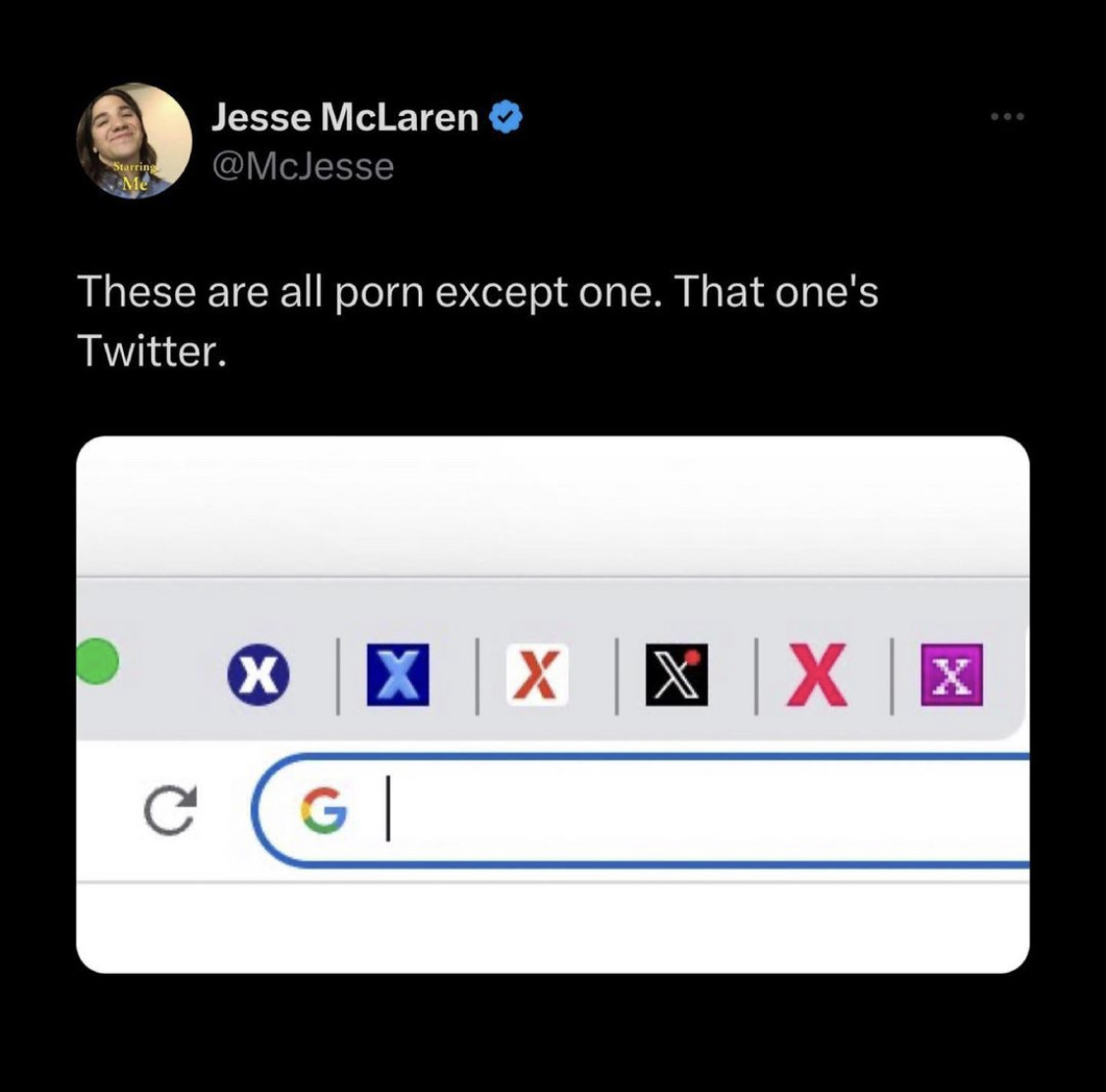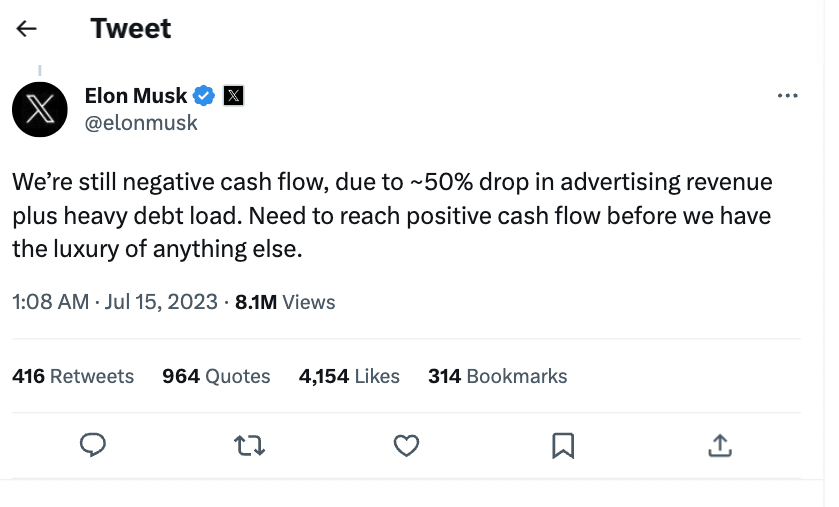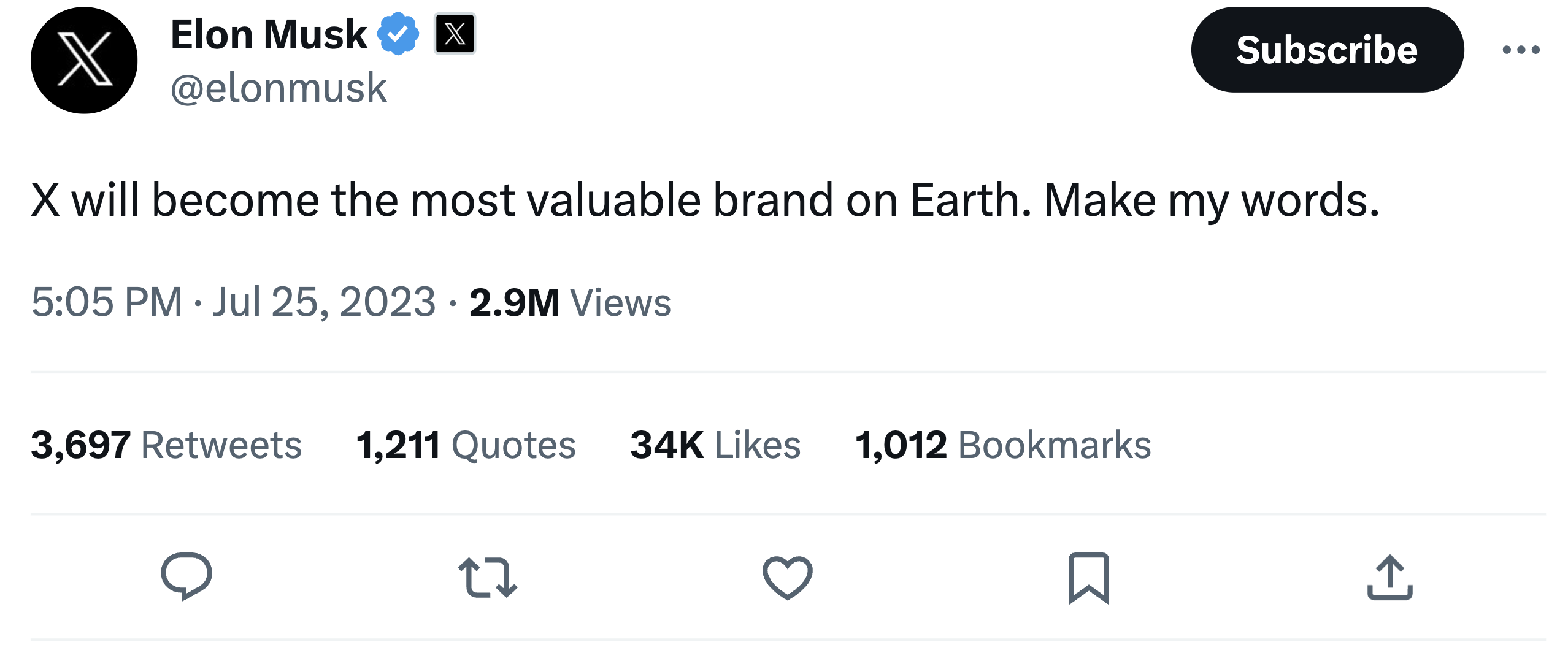
Twitter Is Now X … But at What Cost?
Back in October 2022, billionaire Elon Musk acquired the app formerly known as Twitter. In April, the company quietly transitioned internally to X Corp.
In mid-July, Musk officially went public with the change in identity, sparking a series of events cementing this rebranding as perhaps one of the most infamous in marketing history.
So buckle up, and insert bad ‘x’ pun here. We’re about to walk through what happened and the ripples it’s sent across the internet through four unique digital marketing perspectives.
To be fair, Musk has a long relationship with the letter X. To him, this decision represents much more than a simple name change. Even back in October, Musk was dreaming of a new age town square—the aspirational “everything app.” To quote the man himself:
“The Twitter name made sense when it was just 140-character messages going back and forth – like birds tweeting – but now you can post almost anything, including several hours of video.”
But the rebranding of the platform itself isn’t the actual concern. The haste of and disorder around the change is what’s sending waves across the internet.
We begin our journey where Musk did: design.
People may be equal parts shocked and unsurprised to learn that Musk sourced the new X logo from loyal followers. Crowdsourcing a logo design is a fun idea that’s been done successfully in the past, but, once again, it’s the hasty execution that raised eyebrows.
Musk posted on July 23 that if a good enough design was shared, it could go live as soon as the next day. At the very least, this timeline leaves no room for proper IP procurement. Once the winning submission was announced, Musk almost immediately retracted the new logo for edits.
While the impetuous process of sourcing the new logo from followers has raised concerns among designers and developers, the line weight is irrelevant to what the “X” symbol itself has come to universally represent. As BrainDo Design Lead, Tatiana Knies-Smith, highlights:
“When looking at visual branding online, an ‘X’ is generally a symbol for explicit content. As Jesse McLaren pointed out, looking at a series of website favicons, it’s a potentially confusing brand choice that could make even more people wary of the platform.”

Because of the symbol’s prior connotations, the newly renamed X platform has been blocked in Indonesia, cutting off 24 million active users. According to the Ministry of Communication and Informatics, the block had to do with the explicit content that lived on the previous x.com domain. In a country in which the majority of the population follows the Islamic faith, there are strict laws prohibiting the distribution and consumption of pornographic material.
As such, Musk’s team must now submit a formal letter outlining the types of content that will be permissible on the site—something that runs counter to Musk’s insistence on X being the ultimate safe space for free speech.
But a rebrand is not isolated to just aesthetics. Changes must be implemented with user experience (UX) in mind and across user interface (UI) fields. This ensures an easy transition for the user. Creative Director Brain Schwartz points out:
“If you don’t follow the right steps to launch a rebrand appropriately, it can become very confusing to the end user. They announced the rebrand while Twitter and its associated brand visuals are still loud and proud throughout their digital marketing collateral.”
Sending mixed signals to the user is never good. However, it can be easy to remedy once everyone is on the same page.
What is not an easy fix, however, is another significant hit to profit margins.
Recently, Musk himself admitted that the platform’s cash flow is in the negative and that advertising revenue has dropped by 50 percent.

Trademark attorney Josh Gerben has also stated that there’s a guaranteed chance of the platform being sued. Meta, Microsoft (Xbox), and countless other businesses already have legal rights to the letter ‘X’ in various capacities.
X (the company now, not the letter) is also threatening to sue the Center for Countering Digital Hate over research studying the rise in hate speech on the platform. Findings cited failures to act on or remove 97 percent of anti-Muslim and 89 percent of antisemitic hate speech.
Representatives have called these numbers “inflammatory, outrageous, and false or misleading,” alleging that this contributes to advertisers fleeing the platform.
As our own Paid Media Specialist, Geoff Graham, offers, “Advertisers are already hesitant to run ads on Twitter with the current landscape. And in my opinion, this rebranding will not change the fact that people are still concerned with X’s current leadership.”
With the platform still hemorrhaging money and failing to appease advertisers, settling out of court with even just one company — whether over trademarks or defamation — will drive the platform deeper into debt.
So the rebrand is confusing users and failing to win back the trust of advertisers. At least it’s getting media coverage, right?
But what about the previous 17 years of news coverage, blog posts, links, and embeds? For some search engine optimization (SEO) specialists, this could be an absolute nightmare.
Our own Vice President of SEO, Ron Sansone, expresses concern over the less-than-polished rebrand initiative:
“There’s an entire ecosystem of twitter.com backlinks and t.co short links that must be accounted for as part of a structural transition. If URLs are transitioned improperly (or not at all), X could lose a substantial amount of link signals accrued by Twitter, sever existing connections, and lose Organic positioning within the real-time results landscape to new micro-blogging competitors.”
At the time of writing, x.com still redirects to twitter.com — not the other way around. But if executed with the same level of consideration as the logo rollout, innumerable webpages could suddenly return 404 Errors when we see the full domain switch.
People are confused, advertisers are gone, and webpages everywhere are at risk of breaking. What’s next? The last thing any marketer, advertiser, or user may have held out hope for: the culture.
A short aside: I, Rachel Rhodes, am both author of this article and Social Media Manager at BrainDo. As it overlaps with Organic Social marketing, I must now provide my own professional perspective on Twitter’s rebranding.
Like countless others, I was raised on early iterations of social media. Whether these platforms have cemented themselves as goliaths (YouTube) or faded into history (MySpace), social media played a significant role in shaping modern communication, individual outlooks, and cultural connectivity. As articulated by BrainDo’s Social Media Manager:
“Culture is the currency of social media. We recommend different platforms to different brands based off each platform’s established personality, audience, and public perception. If a brand is present on every platform, then content and tone may fluctuate to fit into the ecosystem of each individual space. When you dismantle a platform’s culture, you lose the value it holds to advertisers, marketers, and users alike. Everyone is alienated.”
Many users were reluctant to bid farewell to Twitter. Others felt they had no choice.
Gene X Hwang, professional photographer and business owner, had long owned the handle @x — that is, until it was taken from him overnight.
Usually, people receive compensation in exchange for an in-demand username or domain. All Hwang received was a letter thanking him for his “loyalty” and offering a tour of the company’s headquarters. This response is within X’s right, of course, but the behavior also suggests just how “loyal” X feels towards its own users—which is to say, not very.
Experts now report that this rebrand has cost Twitter, or X, billions of dollars in brand value. This assessment doesn’t appear to faze Musk though:

What Musk fails to recognize is that Twitter is gone. Twitter had over 15 years of brand value, user culture, and partnerships aligned with its culture. X does not.
As it stands, X is still an unknown element. And this transitory phase will take time to reinstate a sense of platform personality. Until we know who X is, advertisers and users alike may remain cautious.
Once again, Musk finds himself at the center of innovation. But Twitter’s rebranding play comes at a cost. Some expenses are concrete, like paying advertisers. Others are more abstract but no less impactful, like the loss of users’ trust. Will burning the platform down to rebuild truly be worth it?
Ultimately, X (the platform, not the character) will likely persist. In the meantime, brands, advertisers, and internet users everywhere are exploring their options. Some are experimenting with Threads. Others jockey for spots on the BlueSky waitlist. And the rest have an eye out for the next great innovators.
But there is only one guarantee within the world of social media: Change is always around the corner. For better or for worse.